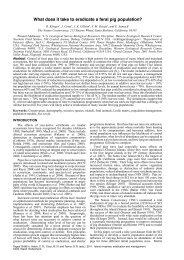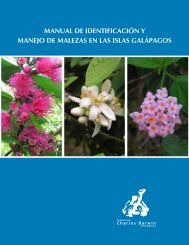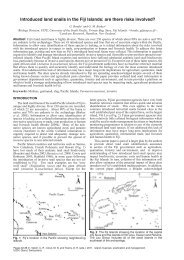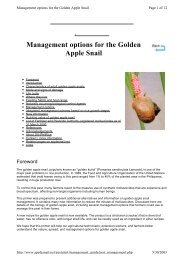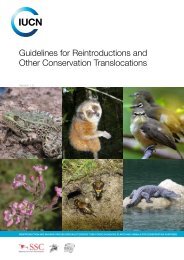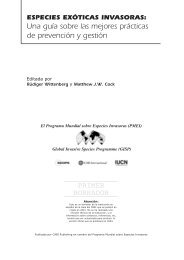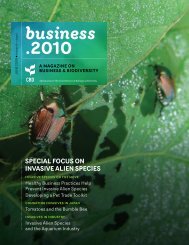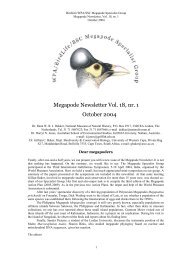Aliens Newsletter - ISSG
Aliens Newsletter - ISSG
Aliens Newsletter - ISSG
You also want an ePaper? Increase the reach of your titles
YUMPU automatically turns print PDFs into web optimized ePapers that Google loves.
GM crops forced governments and industry to consider<br />
ethics and community participation, helped by<br />
simple messages and scenario mapping. Given the<br />
unprecedented scale of the expected changes that are<br />
coming, policy makers that subsidise biofuel cropping<br />
and regulate new industrial crops can use this<br />
past experience (e.g. with Bt Cotton) to include similar<br />
sustainability and IPM imperatives.<br />
In Brazil a switch of sugar cane to biofuel production<br />
was simple because the IPM strategies were in<br />
place, although sustainability issues remain around<br />
further land clearing. Scientists and the contractors<br />
who grow the new crops are likely to have the background<br />
expertise, but to develop IPM systems de novo<br />
requires high investment for fledgling industries<br />
and strong levels of science and industry cooperation.<br />
New crop profit levels dictate the capacity for IPM,<br />
so, while biofuel crops are supported by government<br />
subsides and buy back guarantees there will be little<br />
capacity for pre-planting proactive pest management<br />
research and maintaining healthy sustainable<br />
landscapes. This highlights the folly of linking biofuel<br />
production to “marginal land”. Here production<br />
too will be marginal and impacts on biodiversity<br />
more significant. The business case for algal biofuel<br />
is more impressive. Scenario mapped yields, outcomes<br />
and endpoint products directly attracted BP<br />
and Shell. Higher value crops for expressing key industrial<br />
compounds and polymers are coming and<br />
these too would have the margin required for sensible<br />
pro-active IPM. However, a viable and sustainable<br />
bio-energy feedstocks strategy built on low value<br />
new biofuel crops seems both delusionary and a<br />
likely source of long-term environmentally harm.<br />
A general consensus is a need for a global future vision<br />
and plan for agriculture to support the expected<br />
“green revolution” increasing the role of agriculture<br />
in the GDP of developed and developing countries<br />
through higher value production systems, while<br />
providing social development and protection of<br />
ecosystem service and function. Shifting agriculture<br />
to developing countries should not be because of<br />
weaker sustainability criteria. Scenario planning<br />
around future carbon sources, of which agriculture<br />
is only a part, can be assisted by multi-disciplinary<br />
research agencies.<br />
Policy summary workshop<br />
Future directions needed for policy recognised the<br />
strategic need for national policies to plan and oversee<br />
the implementation of bio-energy and bio-industry<br />
cropping systems. This should capture the context<br />
for a comprehensive risk analysis (user pays)<br />
for quarantine requirements for importation, initial<br />
field trials (as for GM) and pre- and post border<br />
management guidelines (e.g. like South Australia<br />
has done for Arundo donax). Benefits also need to<br />
be considered. Proposals should be considered based<br />
on a business case that captures long-term economic<br />
viability (beyond government subsides) and the<br />
potential scale of production based on realistic assessments<br />
of the amount of available land. The potential<br />
impacts could be addressed by an Environmental<br />
Impact Statement (EIS) that has on the<br />
ground consideration of 1) direct risks of biological<br />
invasions in the proposed regions and the scale<br />
of production even if species is already present in<br />
the country (e.g. large plantings of Pomgania into<br />
northern Australia), 2) food security- direct competition<br />
with food cropping, 3) likelihood of pests impacts<br />
(statements that new crops would be pest free<br />
e.g. Jatropha have proved a fallacy) 4) likely indirect<br />
economic impacts from new crops acting as a<br />
pathway and source of pests for existing agriculture<br />
based on the proposed scale of production, 5) likely<br />
social impacts; e.g. toxins, allergens and GM on<br />
local communities and contamination of food supply<br />
chains, 6) scaled environmental impacts, pollution,<br />
fire frequency/intensity, water resources, desertification,<br />
land degradation, other ecosystem<br />
services, and 7) consequences under climate<br />
change.<br />
International policy standards, best management<br />
practices and agreement mechanisms are needed for<br />
assisting developing economies and under developed<br />
countries with defining high value bio-energy<br />
and bio-industries when approached by investors<br />
for plantations and for imports and exports. First<br />
step would be standards for national policy development,<br />
regulatory processes, infrastructure and capacity<br />
building for sustainable land use for non-food<br />
crop production prior to government/industry initiating<br />
bio-energy/industry production systems. EIS<br />
and WRA could be adapted for such countries for<br />
rapid risk screening/ranking of proposed new<br />
species importation and planting including the inclusion<br />
of scaling issues and indirect effects (as<br />
above). Standards should also incorporate existing<br />
standards on effective and flexible quarantine systems,<br />
given lack often poor capacity for prevention,<br />
and on use of GM technologies likely to be more<br />
widely applied to add value to non-food cropping.<br />
These would add to the existing International Plant<br />
Protection Convention standards linked to the Convention<br />
on Biological Diversity and run through regional<br />
plant protection organisations.<br />
International and national based certification<br />
schemes for sustainability of bio-energy imports/exports<br />
(similar to wood product certification) could<br />
follow from effective EIS mechanisms based on car-<br />
<strong>Aliens</strong> 31



